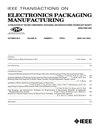Drop-on-Demand Solder Droplet Jetting System for Fabricating Microstructure
IEEE Transactions on Electronics Packaging Manufacturing
Pub Date : 2008-07-09
DOI:10.1109/TEPM.2008.926285
引用次数: 71
Abstract
The novel drop-on-demand (DOD) solder droplet jetting system, which can be characterized as the non-heat affection of the piezoelectric actuator, the control mechanism of the piston head-to-nozzle distance, and disposable nozzle parts, is devised. This system consists of the piezoelectric actuator, insulator, piston head-to-nozzle distance control apparatus, pressure control unit, and furnace. For the modulation of the droplet size, the distance from piston head-to-nozzle exit can be controlled by using the piston head-to-nozzle distance control apparatus. The working temperature is improved by locating the piezoelectric actuator outside of the furnace and by inserting the insulation block between the print head and the actuator. From a practical point of view, the DOD solder droplet jetting system has a simple structure for easily interchangeable nozzle parts. We derived the equation of the ejected droplet volume as a function of design parameters and operating conditions. The prototype of the DOD solder droplet jetting system was fabricated and the performance was verified. The diameter, volume and velocity of the ejected solder droplet are around 65-150 mum, 140 pl-1.8 nl, and 2.8-4 m/s, respectively. We also experimented with the effect of varying the chamber pressure, piston head-to-nozzle distance, and operating frequency on the ejected droplet diameter and velocity. The high aspect ratio vertical columns and inclined columns were fabricated by using the DOD solder droplet jetting system.用于微结构制造的按需焊点喷射系统
设计了一种新型的按需焊点喷射系统,该系统具有压电致动器不受热影响、活塞头喷嘴距离控制机构和一次性喷嘴部件的特点。该系统由压电致动器、绝缘体、活塞头喷嘴距离控制装置、压力控制单元和炉膛组成。对于液滴大小的调制,从活塞头到喷嘴出口的距离可以通过使用活塞头到喷嘴距离控制装置来控制。通过将压电致动器置于炉外,并在打印头和致动器之间插入绝缘块,提高了工作温度。从实用的角度来看,国防部焊锡液滴喷射系统具有易于互换喷嘴部件的简单结构。导出了喷射液滴体积随设计参数和工况变化的方程。制作了DOD焊滴喷射系统的原型,并对其性能进行了验证。喷出的焊锡液滴直径为65 ~ 150 μ m,体积为140 μ l ~ 1.8 μ l,速度为2.8 ~ 4 μ m/s。我们还实验了不同的腔室压力、活塞头到喷嘴的距离和工作频率对喷射液滴直径和速度的影响。采用焊接液滴喷射系统制备了高纵横比垂直柱和倾斜柱。
本文章由计算机程序翻译,如有差异,请以英文原文为准。
求助全文
约1分钟内获得全文
求助全文

 求助内容:
求助内容: 应助结果提醒方式:
应助结果提醒方式:


